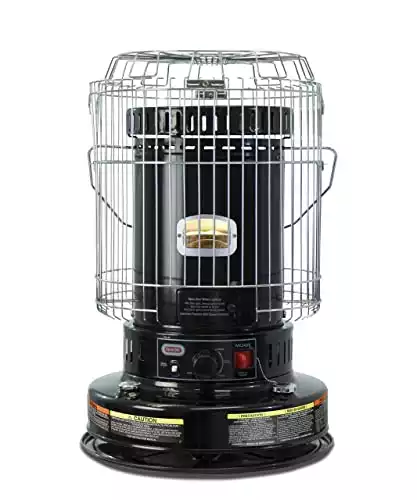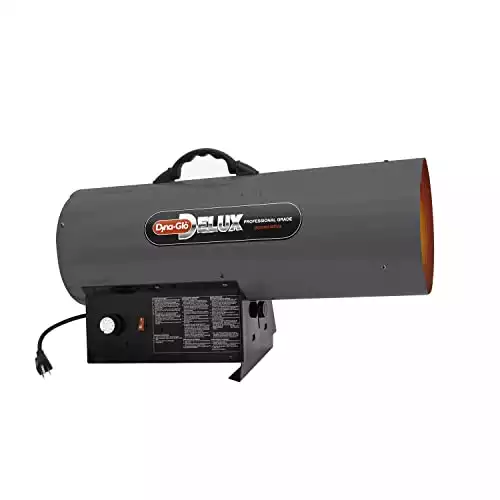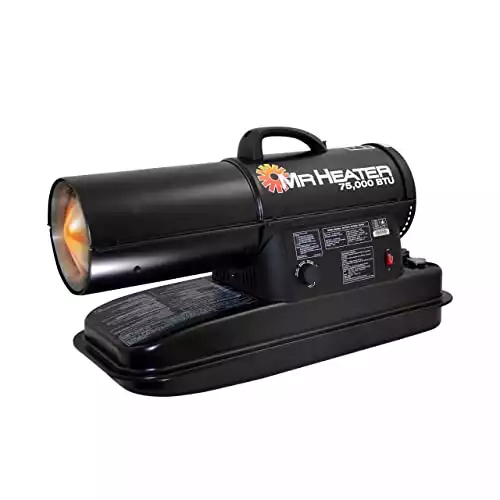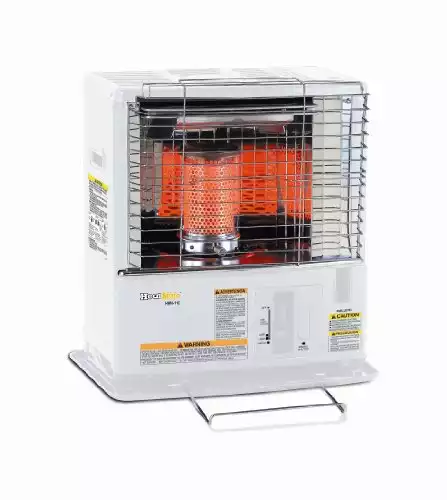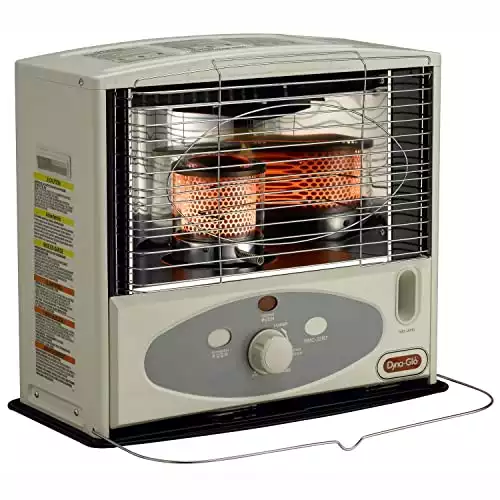[ad_1]
Every winter, power outages inevitably hit. When they do, hundreds or even thousands of people find themselves without heat during winter.
Because of how frequent power outages are (including outages that last for 3+ days!), all homes should have an emergency heater.
A kerosene heater is one of the best options for most people.
Also see: Kerosene vs Propane Heaters
Choosing a Portable Kerosene Heater
There are two types of kerosene heaters. You must get the right type for your space, or you can end up with problems like releasing too much carbon monoxide.
Convection Kerosene Heaters:
These are usually cylindrical. The fuel tank is on the bottom, and the wick is on the top. A grill around the heater is added for safety.
Convective heaters will distribute warmth upwards and outwards. They are designed for large areas or multiple rooms. You’ll have to move the entire unit outdoors to refuel.
Radiant Kerosene Heaters:
These are usually rectangular. They have a reflector or even fan for directing heat in one direction.
Most of these heaters will have a removable fuel tank, so you won’t have to move the entire unit for refueling. Radiant heaters are only suitable for smaller spaces.
Forced Air Kerosene Heaters:
These are the most common kerosene heaters and are often used in workshops. They don’t have wicks and heat up very quickly. The main issue is that they require electricity to run their fan, which means they aren’t ideal for power outages.
Safety Tips and Features
Safety should be your #1 concern when choosing a kerosene heater. Luckily, most modern kerosene heaters are designed for safety.
You’ll still want to look for these features:
BTU Rating
The BTU rating is the measure of energy produced by a unit. Do not make the mistake of buying a kerosene heater with a higher BTU rating than you need!
While it might seem logical to buy a high BTU heater “just in case,” a unit rated too high for a space can cause problems.
First off, there are issues of efficiency. A kerosene heater will only operate efficiently if run at its maximum BTU. Trying to reduce the heat level will just cause you to waste fuel. It can also cause incomplete burning and foul odors.
Another issue is that high BTU heaters will produce more carbon monoxide. When used in a small space, this can be dangerous.
Calculating BTU Requirements: As a general rule of thumb, take the square footage that needs to be heated and multiply by 28. So, a 360square foot room will need a 10,080 BTU kerosene heater. You can also use this BTU calculator.
Recommended Kerosene Heaters
Dyna-Glo 23,800 BTU Indoor Kerosene Convection Heater
Dyna-Glo is one of the leading names in kerosene heaters. Their 23,800 BTU convection heater is easy to use and the right size for most home uses.
Read the user manual before lighting this heater if you aren’t familiar with kerosene wick heaters. Once you do, you’ll find that the Dyna-Glo 23,800 is pretty easy to use.
The heater uses only kerosene fuel. While some users claim they’ve cut the fuel with diesel to save costs, this isn’t recommended. Diesel is too dirty for this heater to handle. Read more about using diesel in a kerosene heater.
The fuel tank holds almost 2 gallons of kerosene. Once you light the heater, it heats a room VERY quickly. At maximum setting, you might only get 4-5 hours of run time from a tank, though.
It’s easy to refill the tank because it lifts out. A fuel siphon is even included with the heater.
A cool thing about convection kerosene heaters designed like this (with a flat-topped safety grill) is that you can heat food on top of it – a great feature to have during power outages.
There are also all the standard safety features you’d want from an indoor heater.
Best For: Everyday use, such as heating garages and heating inside your home during power outages.
Dyna-Glo Deluxe Kerosene Forced Air Heater
This model of Dyno-Glo kerosene heater comes in different BTUs, from 50k to 220k. It lives up to its “Deluxe” name. There are lots of controls, and I particularly love that the fuel gauge shows how many hours of heating you have left.
With the 80k option, the heater can heat up to 1,900 square feet. And it will heat the space FAST! Of course, that amount of strength means you’ll go through fuel quickly.
A nice thing about Dyno-Glo is that they have good troubleshooting. If something isn’t running correctly, you can scan the QR code of the product, and it will ask you questions to help you figure out what is wrong.
The only downside of this heater is that it is a bit loud when running (which is expected of forced air kerosene heaters). Also, note that this is a forced-air heater. It needs to be plugged in for the fan to work.
Best For: People who need a powerful heater for large spaces. You’ll want a generator to power the forced air for emergency heating. See best indoor generators and best propane generators.
MrHeater 75,000 BTU Forced Air Kerosene Heater
Mr. Heater makes several models of forced air kerosene heaters. Their 75K BTU option has a 6-gallon fuel tank that can run for 11 hours on kerosene. The best thing about the heater is probably how easy it is to use.
With the 75k heater, you can heat up to 1,875 square feet. The fuel tank is 6 gallons larger than other kerosene heaters of similar strength.
The larger tank size means the heater will run longer (about 11 hours), but the heater is heavier at nearly 40lbs.
If you have a bad back, you might want to get the Mr. Heater 125,000 BTU model instead, which is on wheels and easier to move.
Another reason to spring for the 125,000 BTU model is its built-in diagnostic tools like blinking LED lights. However, 125K BTU is too powerful for many indoor needs, so don’t decide based on this alone.
As expected with a forced-air heater, it’s loud when running. You will also need electricity for the heaters fan, so it isn’t the best option for power outages unless you also have a generator.
Best For: People who want a powerful heater that can run for longer on a single tank. Remember that it also needs electricity to run the fan, so it isn’t suitable for power outages.
Sengoku HeatMate Omni-Radiant
For such a small heater, this Sengoku heats surprisingly well. The key is in its efficiency. The tank is only 1.2 gallons but can heat up to 380 square feet for over 12 hours.
However, some users report that a tank will only last for 6 hours, even on a low setting. Run time can vary drastically depending on the quality of your kerosene.
Small heaters do come with their downsides, though. It will take a while to heat a room, and it isn’t doing much for a large space.
You’ve also got to be very careful with the positioning of the wick. If it gets set too low, you can expect some bad odors.
Best For: Great backup heater, primarily because of fuel efficiency. As a supplemental heater, it is only suitable for small spaces.
Dyna-Glo RMC
At first glance, the fuel efficiency of this kerosene heater seems impressive. Yes, it can run for 13 hours on one tank – but it isn’t as hot as other heaters of equal rating.
That said, it is still a reliable heater that can heat up to 500 square feet. It is easy to use and has logical controls.
The only real issue with this Dyna-Glo heater is that the wick is hard to adjust. You don’t get much leeway in length, which means you can get nasty odors.
Best For: Wonderful emergency heater for locations that don’t get insanely cold. In a very cold climate, ensure you also have sleeping bags or wool blankets. The fuel efficiency means it is also a good choice for supplemental heating.
How Do Kerosene Heaters Work?
Unlike most other fuel-based heaters, kerosene heaters require a wick. The wick absorbs the kerosene. When ignited, it carries the flame into the kerosene fuel to light it and produces heat through combustion.
The design of the heater allows the amount of oxygen reaching the fuel to be regulated. The flame can also be controlled by increasing or decreasing the wick length.
Pros/Cons
Admittedly, kerosene heaters aren’t my first choice of backup heater. I have a wood-burning stove with a duct system that channels the heat throughout the entire home.
However, most people don’t have a reliable source of wood, nor do they want to chop lots of wood or install an expensive system “just in case.”
By comparison, kerosene heaters are reasonably cheap and don’t require any installation. You take out the heater as needed during emergencies.
Pros
Cons
Is It Safe to Use Kerosene Heaters Indoors?
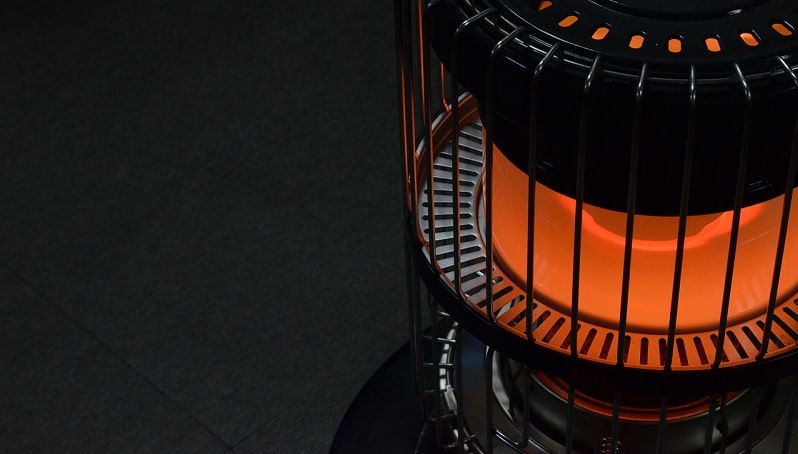
Yes, it is very safe, but there are always some best practices to follow, as with any combustion heater (including gas, propane, and wood).
Kerosene and Carbon Monoxide (CO)
Kerosene heaters (along with oil, wood, gas, and propane heaters) burn oxygen in the air and release carbon monoxide. In addition to the CO, kerosene heaters can release other pollutants such as sulfur and nitrogen dioxide.
To reduce the risk of asphyxiation due to carbon monoxide poisoning, you must vent the heated room!
This is as simple as leaving the door to an adjoining room open or opening a window 1 inch.
I would also recommend installing a carbon monoxide detector in your home.
As a general rule, you will need 1-4 square inches of fresh air ventilation for each 1000 BTU of heater capacity.
Toxic Fumes from Kerosene
Kerosene is a liquid, but it can evaporate into the air. When it evaporates, it can produce toxic fumes.
Generally, these fumes aren’t a big concern. People long used kerosene for killing head lice and cleaning (though health agencies advise against this now).
However, to play it safe, you should ensure that you aren’t exposed to any kerosene fumes. Always refuel your kerosene heater outdoors.
Bad Odors
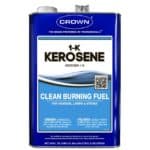
Kerosene heaters release some odor as they reach maximum heat (usually about 45-60 minutes), but the smell should NOT be strong or nasty.
The odor should also stop after max heat has been reached. It is a sign of a problem if you get a foul smell from your kerosene heater.
Usually, a foul odor occurs because of low-quality fuel. The fuel might not be Grade K-1 or contaminated (if the fuel is old and wasn’t stored properly).
These fuels won’t burn completely, resulting in a bad smell.
Another cause of bad odors is incomplete burning, such as from too low a temperature or an incorrectly placed or sized wick.
Your kerosene heater should always be on high heat, with the temperature only turned down enough to prevent soot from forming.
Kerosene Heater Safety Best Practices
- Install a CO detector in your home.
- Ensure the room is well ventilated – leave a door or window open.
- Never leave a kerosene heater unattended.
- Keep the instruction manual nearby.
- Choose a model with a BTU rating suited to the space you want to heat.
- Keep the wick at the proper length instructed by the manufacturer.
- Only use Grade K-1 kerosene
- Fuel should be clear; do not use yellow or red fuel
- Store kerosene in containers designed for kerosene
- Make sure your kerosene storage containers are clearly marked
- Refilling should only be done outdoors and when the unit is cool
- Use a siphon pump for refilling to prevent spilling
- Keep heater away from all flammable and combustible items (such as curtains, furniture, aerosol sprays, and gasoline)
Cleaning Up Spilled Kerosene
Spilled kerosene is potentially very dangerous, as it can catch on fire. Use a siphon to prevent spillage when refueling. If spilling does occur, follow this advice:
- Use rags to absorb as much of the spilled kerosene as possible. Large spills can be absorbed with kitty litter or sawdust.
- Don’t use water-based cleaners on kerosene. Water and kerosene don’t mix.
- Mix dish soap with warm water. Use it to wipe the area of the spill.
- If possible, use fans to speed up the evaporation of the kerosene fumes. Make sure the space is well-ventilated.
How to Add Fuel to Your Heater
A siphon is the safest way to add fuel to a kerosene heater. If you must manually pour to refuel, make sure you use a funnel and pour very carefully! Clean up any spills immediately.
Only add fuel to a kerosene heater when it is turned off and cool. Always take the heater or fuel container outdoors for refueling.
How to Store Fuel
Compared to other fuel types (such as gasoline), kerosene is very easy to store. It lasts a long time and won’t freeze or evaporate.
Make sure you have an approved container for storing the kerosene. You mustn’t use glass as it can absorb heat and cause the kerosene to ignite.
Most kerosene containers are plastic. Metal is the best option if you want to store kerosene for long periods.
Kerosene containers are blue. Some people say it is okay to use gasoline containers to store kerosene. However, this is a terrible idea.
Aside from the potential for mix-ups, kerosene doesn’t last as long in plastic containers.
- Use clean, sealed containers for storing kerosene
- If possible, use metal containers for kerosene
- Keep away from heat and light
- Only store kerosene outdoors
- Kerosene can be frozen, but this will make it thicker and more challenging to pour
How Long Can Kerosene Be Stored?
As a general guideline, kerosene lasts 1-3 months. To play it safe, you should discard and replace any kerosene not used by the end of the heating season.
However, many people report storing kerosene for years (even as much as 10+ years) without any problems. This old kerosene will still burn, but tainted kerosene could damage your heater or cause foul odors when burning.
Testing Kerosene Quality
If you aren’t sure whether your kerosene is still “good” or not, you can use this visual testing method.
- Put a small amount of kerosene in a clean glass jar.
- Let it sit for 1 hour.
- Quality kerosene will not have any debris or bubbles. It will be clear.
- Tainted kerosene will be yellow or cloudy, have bubbles or visible contaminants.
When quality kerosene is burned, it won’t produce an odor after reaching the ideal burn temperature.
If you see smoke or sense a bad smell, the kerosene shouldn’t be used.
Care and Maintenance
The most important thing you need to know about kerosene heater maintenance is that the wick needs regular care. You can read instructions on how to care for a wick here.
You’ll have to check the manufacturer’s guidelines for your specific kerosene heater. Here are some general guidelines:
- Store the fuel tank separately from the rest of the heater
- Only use K-1 kerosene for cleaning the inside of the fuel tank
- Use a nonflammable cleaner (such as water with ammonia) to clean the heater’s outside.
- After every 2-3 refuelings, the wick should be “dry burned” and brushed.
[ad_2]
Source link

